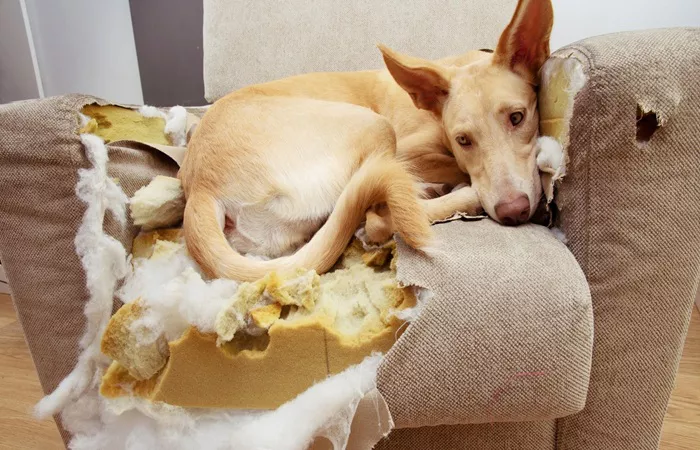A dog has captured widespread attention after destroying a family couch, leaving a hole large enough for the dog to fit inside. The incident, shared on TikTok by user Madi, has gone viral, amassing over 1.5 million views and 304,400 likes. Madi described the damage as the result of Kona, the dog, getting anxious and “eating a safe space” in the couch. In the video, Kona appears completely unbothered by the damage, comfortably nestled in the hole.
Experts weigh in on the cause of such behavior. Ali Smith, CEO of Rebarkable, explained that dogs may resort to destroying furniture due to a combination of instinctual and emotional factors. She suggested that nesting or settling behaviors could escalate into destruction, though this usually doesn’t cause severe damage. The more significant issue, she said, is that chewing or shredding can provide biological satisfaction, which helps alleviate anxiety—similar to comfort eating for humans.
Smith emphasized that pet owners should differentiate between various types of anxiety. Separation anxiety typically occurs when an owner leaves the house, while boredom can lead to random destructive behavior. She encouraged owners to address smaller stressors, such as loud noises or disruptions to routine, and ensure their pets are sufficiently enriched. If the problem persists, Smith recommends gradually addressing the root cause with training rather than relying on quick fixes like crating, which could worsen the anxiety.
Ivan Petersel, founder of Dog Virtuoso, agreed that destruction often results from unmet needs. He advised owners to provide mentally stimulating tools, such as puzzle feeders or snuffle mats, to help dogs channel their energy and intelligence. Petersel also highlighted the importance of ruling out medical issues with a veterinarian, especially if the dog is consuming materials.
Regarding Kona’s behavior, Petersel questioned the notion of a “safe space,” suggesting that the dog simply enjoyed the feeling of the hole. He advised owners to identify the type of behavior at play, as timing and intensity are crucial. While boredom can be alleviated with enrichment, separation anxiety is tied to the owner’s absence, and compulsive behavior is repetitive and difficult to interrupt.
To prevent further destruction, Petersel recommended early intervention, such as redirecting the dog’s attention before it begins chewing. He also suggested using methods like tether training or crate training (when anxiety is not the issue) to manage dogs’ behavior. For owners facing ongoing problems, Petersel recommended recording their pets when left alone to better understand their actions.
TikTok viewers quickly related to the situation, sharing their own experiences with destructive pets. Some offered advice, such as covering the damage with a pillow, while others shared amusing stories of similar incidents. One user recalled their puppy being so frightened of fireworks that it vomited on their father’s desk. Another commenter shared how their dog had created a hole in their mattress, which they lived with for months.

